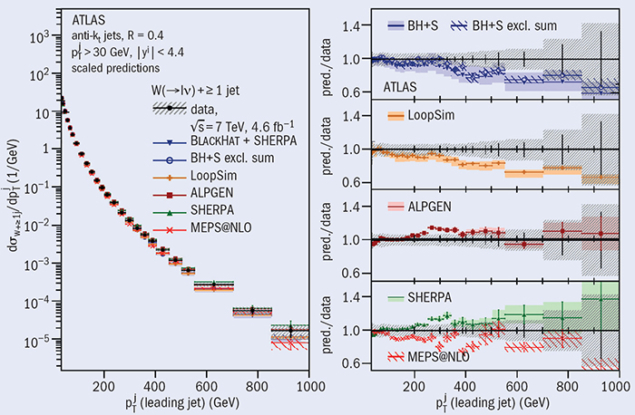The ATLAS collaboration has updated its measurement of the production of W bosons in association with jets (W+jets), which is an important channel at the LHC for precision comparisons with QCD. A precise understanding of these event topologies is also vital for searches for physics beyond the Standard Model because many new models predict a similar experimental signature.

In recent years, the analysis and understanding of W+jets production has undergone two major advancements. The first is the large amount of data available from the LHC, and the extended kinematic reach that results both from the collider’s centre-of-mass energy – which allows for measurements of jets with a transverse momentum (pT) of up to 1 TeV and multiplicities of up to seven jets – and the expanded detector calorimeter coverage, which can measure jets at large rapidities. Unlike at previous colliders, where the pT values for the jets were a few hundred giga-electron-volts at most, the transverse momentum of the jets at the LHC can be more than an order of magnitude larger than the mass of the W boson itself. In these cases, large QCD corrections can be associated to the multiple scales in the event, and these are difficult to predict by fixed-order calculations. Also, because of the disparity in the scales between the mass of the W boson and the pT of the jet, electroweak corrections can play a major role. The second advancement is the availability of next-to-leading-order (NLO) predictions in perturbative QCD for events with large numbers of associated jets. These calculations have smaller theoretical uncertainties compared with leading-order predictions.
The recent ATLAS measurement of W+jets production focuses on detailed comparisons between the jet and event properties that are observed and several state-of-the-art theory predictions. The figure highlights the differential cross-section as a function of the pT of the leading jet, i.e., the highest transverse momentum. The data are compared with leading-order calculations (Alpgen, Sherpa), NLO calculations (Blackhat+Sherpa, MEPS@NLO), and beyond NLO calculations (LoopSim, Blackhat+Sherpa exclusive sums). At large values of the jet’s pT, the higher-order calculations tend to underestimate the data. In these regions of phase space, additional corrections to the cross-sections from electroweak diagrams are expected to be sizable. However, they are also expected to be negative, and therefore cannot account for this trend. The leading-order predictions model this particular distribution better, but in other kinematic observables, such as the jet rapidity, their description of the data is not as good.
This result is based on the measurement of more than 25 different properties of W+jet events. No single theoretical prediction can describe the data accurately for all distributions. These results will help to improve understanding of QCD and motivate more accurate theoretical calculations for future comparisons with data.
Further reading
ATLAS Collaboration 2014 arXiv:1409.8639 [hep-ex], submitted to Eur. Phys. J. C.





